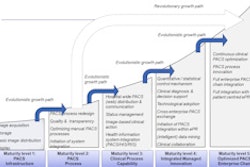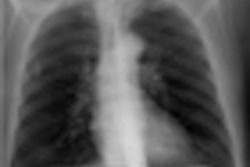
A bold and ambitious plan to make the medical records of Hong Kong's 7 million citizens electronically accessible is showing signs of success. Today an integrated electronic medical record (EMR) system links the public hospitals and clinics of the Hong Kong Hospital Authority (HKHA): 43 hospitals, 47 specialist clinics, and 74 general outpatient clinics. Enterprise RIS and PACS integration with the EMR system is well under way.
Dr. H.K. Huang, professor emeritus of radiology and biomedical engineering at the University of Southern California in Los Angeles and chair professor of medical informatics at the Hong Kong Polytechnic University, presented an update of the status of enterprise RIS/PACS integration at the 2011 Computer Assisted Radiology and Surgery (CARS) congress in Berlin. To learn more, AuntMinnieEurope.com subsequently interviewed Huang and consultant radiologist Dr. Lilian Leong, chairman and founder of the HKHA's radiology IT steering group.
The Web-based enterprise system today
The information technology planners of the HKHA had their original vision in the 1990s, a decade when RIS, PACS, and EMR software were being installed in visionary hospitals that saw potential in these evolving new technologies. As with many enterprise PACS, the technology and systems have evolved through several iterations. What started with clusters of mini-PACS in individual hospitals morphed into full-hospital PACS, then enterprise PACS, then enterprise PACS interfaced with an electronic patient record.
The HKHA has not had a problem that many health systems have: dealing with and needing to merge multiple patient identification numbers. Hong Kong residents are issued with one ID the first time they use a HKHA facility, Huang said. English is the language used in the electronic patient record and the PACS, although names with Chinese characters may occasionally appear in patient worklists.
 An integrated electronic medical record system now links Hong Kong's extensive network of public hospitals and clinics.
An integrated electronic medical record system now links Hong Kong's extensive network of public hospitals and clinics."Any organization developing a large, complex electronic patient record with integrated imaging faces major challenges," Huang said. "Enterprise-level resources are needed to develop and implement the system. A common method is needed for inputting various types of patient records, and the system developed has to comply with specific data and communications protocols and standards. These standards have to be supported by manufacturers, who need to partner both with the enterprise and other manufacturers. And finally, the system has to be enthusiastically embraced by the users at all levels."
The HKHA had a big advantage: Its organizational structure is top-down. Guidelines are issued, implemented, and followed. The IT team has about 800 full-time employees and about another 1,200 contract employees. They work together efficiently within the top-down organizational structure, he explained.
The PACS is configured around a cluster concept. A cluster has one or more flagship hospitals, each of which has a central long-term archive with 100% offsite backup that other hospitals in the cluster share. Individual hospitals may select their PACS vendor of choice. In the current configuration, when an examination is performed, images are transmitted to the cluster's archive, where they are retained in uncompressed format for 30 days. After a diagnosis is made, they also are sent to the IT data center in a 10:1 to 30:1 wavelet compression format with attached diagnostic reports and annotations. Radiologists can retrieve either lossless or lossy images through the RIS/PACS.
Physicians, whether affiliated with HKHA facilities or in private practice, can obtain images through a Web client using a secure token through a public/private interface to the electronic patient records. At least 10,000 workstations with Web-based access to the electronic patient record are deployed, according to Huang.
Leong advised that HKHA had targeted completion of filmless operation within the current five-year radiology IT plan by 2013 or 2014. Dr. N.T. Cheung, chief medical informatics officer, and William Chan, senior systems manager, are overseeing the remainder of this complex project.
Launching a PACS and making it grow
In the 1980s, Leong was responsible for planning the renovation and expansion of the Queen Mary Hospital Radiology Department where she worked as a consultant radiologist. By the end of the decade, she was planning and commissioning the radiology departments of all the new public hospital projects of the HKHA.
Leong became interested in digital imaging as soon as the first modalities and PACS were commercially introduced. In Hong Kong, as in the rest of the world, the belief that anything related to healthcare IT was the purview of the IT department. Imaging informatics was an unknown concept. Working with another radiologist, Dr. F. Chu, and two radiographers, Leong and colleagues began to visit HKHA hospitals to talk with administrators, hospital planners, and various project teams about computed radiography and PACS.
"I had to convince the relevant parties that for radiology, close collaboration with radiologists, technologists, and clinicians was mandatory in order to develop an appropriate and workable system especially designed for image transmission and distribution," she said. "It was a long and tedious process to convince everyone that digital equipment would replace a film-based radiology department, and that it would eventually be feasible to transmit diagnostic images to multiple locations."
Funds were allocated for the first PACS in 1995 for a new hospital. The Tseung Kwan O Hospital opened in 1999 as a fully filmless hospital, which also had an electronic laboratory system and a clinical management system. To deal with the different equipment and networking requirements of established radiology departments, Leong established a radiology IT steering group in 1997. Leong chaired this group, which also worked closely with the hospital IT departments, until her retirement in 2006. This group assessed radiology departments' requirements, established strategic plans, and developed an implementation schedule.
The centralized nature of the HKHA benefited EMR and PACS implementation. When it was established in 1990, it was originally organized into nine clusters, then seven clusters, which represented 93% of all hospital services in Hong Kong. It internally developed and beta tested a clinical management system in 2002, by which time several other hospitals had installed variously sized mini-PACS from various vendors. The same year, the HKHA retained Huang to consult on the integration of PACS with the electronic patient record that it was developing and implementing for use by all of its hospitals.
The biggest challenge for Huang and the radiology IT steering group was to figure out how to connect all the hospitals to make radiology reports and key images available to any healthcare provider accessing a patient's medical record. Residents of Hong Kong go to multiple hospitals and clinics, Huang explained, and so access to records from radiology exams performed at any facility was imperative, especially so that physicians would not order duplicate exams for these "roving" patients.
Data migration
Data migration of images archived in various PACS has had the expected challenges. The process took five years, and about 20% of the images did not migrate. Because they represented the oldest images in the PACS, their value in the context of current treatment is probably questionable, according to Huang. The process of migrating data and images from four separate PACS into one central archive serving the Tuen Mun Hospital and Pok Oi Hospital of the New Territories West Cluster took place. These hospitals, with 1,500 beds and 1,000 beds, respectively, are the flagship hospitals for the cluster.
The first initiative was to integrate the two separate hospital RISs and PACs to provide an infrastructure to support the enterprise electronic patient record with imaging system. The Tuen Mun hospital, which was one of the first hospitals of the HKHA to purchase a PACS, had four separate legacy mini-PACS modules from four different manufacturers. Each PACS module contained specific imaging modality images and data that were tied to the vendor's imaging modalities.
Tuen Mun Hospital replaced these with a new PACS (Agfa HealthCare). Pok Oi Hospital had previously purchased a PACS from the same vendor. It was necessary to redesign each of these hospitals' PACS into a unified operation, a process completed in 2010.
But from a data consolidation standpoint, what this ultimately meant was that Tuen Mun Hospital first had to migrate its various PACS archives into the Pok Oi's PACS archive. Then after Tuen Mun Hospital received funding for a new archive some time later, that data was migrated back. In addition, compressed images were transmitted to the IT data center for general physician use.
Ultimate value
How valuable has the electronic patient record with imaging been?
"It has changed and improved the approach to patient management," Leong said. "This project has had major implications on financial and human resources in Hong Kong, but it has proven to be very cost-effective. It has many visible and intangible rewards that benefit a large number of patients and the population in general."
When asked if the Web-enabled EMR system had impacted care, Huang replied, "Most definitely! The doctors I talk to say that without fast access to EMR images -- and these include video and photos, as well as radiology images -- they could not practice anymore. They rely on the system. Medical practitioners initially were very skeptical, but gradually they were impressed by the fact that with it, you can take care of patients so rapidly. Workflow has been dramatically expedited."



















